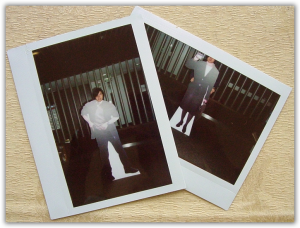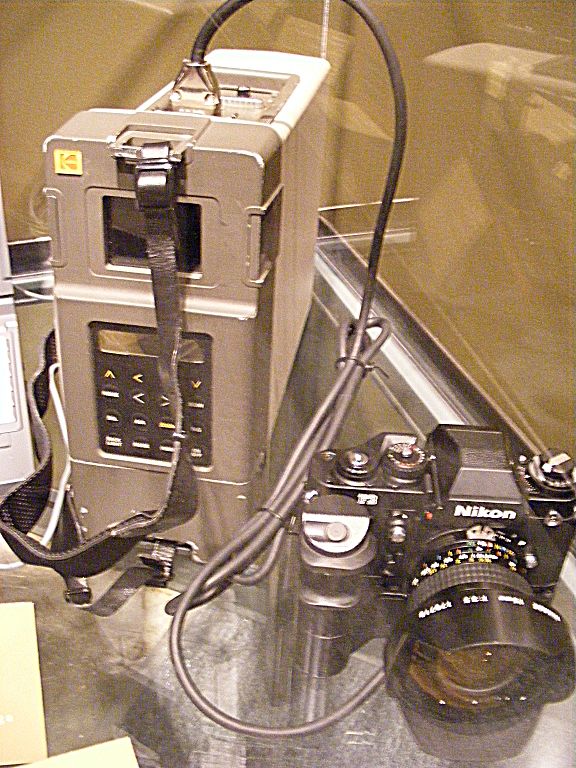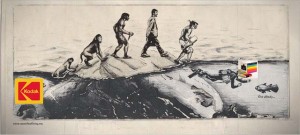aNewDomain.net — Right around 2002, affordable digital snappers flooded the market. Just six years more and Polaroid announced the discontinuation of its iconic instant film and camera line.
Polaroid was the first real victim of the digital camera onslaught. And it’s probably the best example of old guard adaptation. Reinvented via collaboration between two other major film producers as “The Impossible Project,” Polaroid’s afterlife was ultra niche and uber hip. Unsurprisingly, Polaroid based the project in Europe, where people aren’t afraid to embrace old tech — or people over 30, either.
They love themselves. And now they can love using their vintage cameras again. Since March 2010 instant film for Polaroid cameras is back.

Above image of old Polaroid photos: Wikimedia Commons
As for Kodak, the maker of the disc camera system shown below, it fell and fell hard on this project. Take a look at this monster. Kodak’s system is linked up here with a Nikon Auto Winder. The resulting pictures from this system were not as good as these two powerhouse brand names might suggest. In this case, the bigger you are …

Image of an early digital system, the 2 mega pixel Kodak Disc System, credit: Wikimedia Commons
The early disk systems, like the one shown above, form the basis for digital imaging as they were not entirely conventional film-based designs. In 1986, Kodak invented the world’s first megapixel sensor.
But let’s get back to the present. After the December 2008 bankruptcy filing, Polaroid started making the most out of the bankruptcy process, selling its naming rights to third-party camera gear companies. You may find used or vintage TVs, strobes, and DVD players on eBay that were made by the company that resurrected the Polaroid name — the Minnesota-based Petters Group Worldwide. But the Petters Group collapsed in on itself, and probably in part caused the 2008 bankruptcy filing, when Thomas Petters was exposed as running a Ponzi scheme and holding lots of drugs. Somehow this part of Polaroid history went almost unnoticed.
While all this was going on, Kodak on the other hand threw more good money after bad by paying $74 million to have naming rights to the Hollywood, CA theater that hosts the Academy Awards. Kodak lost the prestigious bragging right to hang their name over the building the Oscars are handed out in when it filed for Chapter 11. Big time Hollywood director Brett Ratner was once asked where he invests his money. At the top of his list was Kodak because, “It’s Kodak, the film industry is always going to need film.” Ratner even gave a long interview to Kodak’s Film Online pages and something called InCamera.com where he spent a fair amount of time talking up the value of film. Guess he didn’t realize how much blood was in the water. In 2011 some of the oldest names in building film movie cameras, like Panavision or Aaton, stopped making them.
The list of abandoned film stocks tripped the light switches in darkrooms everywhere. Kodak’s Chapter 11 bankrutpcy should be final this year. Its incredible collection of patents sold for a song to competing companies and patent privateers (aka patent trolls), a fact that angers any ex-Kodak execs you meet at cocktail parties at tech events. The fact is trolls own the Kodak jewels.
Even Kodak’s photo paper, kiosk and scanner operations transferred. Kodak agreed ultimately to stop making digital cameras, too. It was a long and hard-to-watch death.
Dying like the Black Knight in “Monty Python and the Holy Grail,” Kodak’s bankruptcy ordeal remains a grisly, limb-by-limb affair. In the movie, King Arthur told the Black Knight, “Look you stupid (idiot). You’ve got no arms left.” Kodak’s analogous response to the digital onslaught was, “It’s just a flesh wound.” Kodak execs didn’t reinvent their visions in the way Polaroid did, though. Kodak in fact had the potential to turn the corner and create something new.
Consider the Kodak Disc System pictured above the fold. It required that aforementioned Nikon F3 Auto Winder, and the 2 megapixel images paled compared to good ole regular film. A leaf blower is easier to lug than this beast was.
Its inventor, Steve Sasson, had a seat belt on the future, all right.
That future was DSLR, via Nikon’s D90 and Canon’s Rebel. DSLR cameras were the beginning of the end of old-school pro photography. In between Sasson’s magical above-pictured dinosaur and the D90, such companies as Olympus, Canon and Yashika created cameras you could swing on your wrist all over Pioneer Land at Disneyworld. Regular folks found those images good enough for them. “Look honey, I can make my own sepia and black-and-white images of Tom Sawyer’s Island.”
This at once was funny and scary to everyone.
Had Nikon and Canon not spent most of their time fighting over the DSLR market slice of the pie in the first decade of the millennium, maybe — just maybe — pro photographers would still be fragging the amateurs. Those first DSLRs cost as much as a used car. That’s a lot of pocket change to the regular guy on the street.
But every firm from Canon to Nikon to Hasselblad to Leica all strapped themselves in. They made unbelievable pro-quality camera gear that a weekend warrior couldn’t afford — at first. Then the evolution of ridiculously affordable DSLR camera tech started to roll for years.
Just this April, Sears and Walmart announced their cheap in-store portrait studios were down, out and done.
It was the end of an era.
Lifetouch Studio’s Olan Mills, the company whose minions run school photo operations and mall portrait sweatshops, has been amputating various offshoots and operations since 2009.
What if all these mall joints had created studio clubs? The new legions of momtographers, student enthusiasts, photographers and regional photo club members could all rent studio time, or take classes on the art form and tech of photography. That would have been the ticket for Kodak or someone else partnered with Kodak.
An in-store website manager could add on all the new wave of consumers’ social media needs as well as train these folks. They blew it, Kodak-style. You get what you get and you don’t get upset, as kindergarten teachers tell five-year-olds today. Or as lifeguards say, don’t even try to fight a rip tide. You swim with it or drown.
In the next revolution, it’ll be your choice to have a Polaroid or Kodak moment. For aNewDomain.net, I’m Viki Reed.
Image credit: Viki Reed
Based in New York, Viki Reed is a senior photographer and pop culture commentator at aNewDomain.net. She’s worked with SubBrilliant News, Anti-Press and Thewax. Check out her work at vikireedphotography.com and email her at Viki@aNewDomain.net or viki@vikireedphotography.com.














This is a beautifully written essay, Viki.
Kodak can still today create a full frame rangefinder 24mp digital camera with real manual dials for ISO, aperture, shutter speed, and compensation and less digital crap and rule the world. The world is not happy with the Mr. Roboto version of a digital camera, hence the Fuji 100s and the Leica 9 still sell like blazes. Kodak had no vision and became mgmt top heavy. Thats the only reason they died. They used Nikon bodies not NEW ones built for digital. Their grafted on packs made the camers ridiculous looking and they were overpriced. Their sensors and research ere part of the revolution to getting there but … they failed to jump on board to the wave
as for polaroid… many are converting their great camers to 4×6 format. why couldnt they think of that!